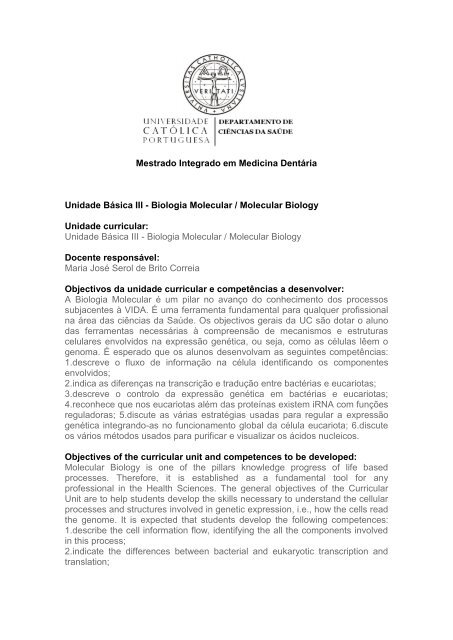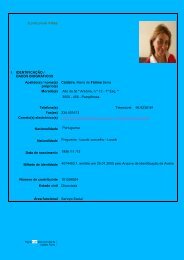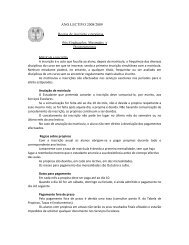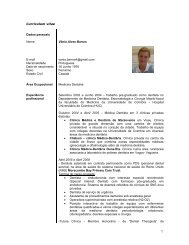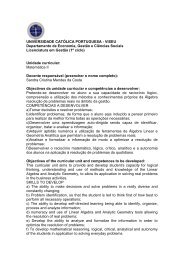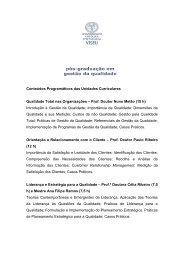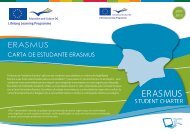Anexo IX - Unidade Básica III - Biologia Molecular / Molecular Biology
Anexo IX - Unidade Básica III - Biologia Molecular / Molecular Biology
Anexo IX - Unidade Básica III - Biologia Molecular / Molecular Biology
You also want an ePaper? Increase the reach of your titles
YUMPU automatically turns print PDFs into web optimized ePapers that Google loves.
Mestrado Integrado em Medicina Dentária<strong>Unidade</strong> <strong>Básica</strong> <strong>III</strong> - <strong>Biologia</strong> <strong>Molecular</strong> / <strong>Molecular</strong> <strong>Biology</strong><strong>Unidade</strong> curricular:<strong>Unidade</strong> <strong>Básica</strong> <strong>III</strong> - <strong>Biologia</strong> <strong>Molecular</strong> / <strong>Molecular</strong> <strong>Biology</strong>Docente responsável:Maria José Serol de Brito CorreiaObjectivos da unidade curricular e competências a desenvolver:A <strong>Biologia</strong> <strong>Molecular</strong> é um pilar no avanço do conhecimento dos processossubjacentes à VIDA. É uma ferramenta fundamental para qualquer profissionalna área das ciências da Saúde. Os objectivos gerais da UC são dotar o alunodas ferramentas necessárias à compreensão de mecanismos e estruturascelulares envolvidos na expressão genética, ou seja, como as células lêem ogenoma. É esperado que os alunos desenvolvam as seguintes competências:1.descreve o fluxo de informação na célula identificando os componentesenvolvidos;2.indica as diferenças na transcrição e tradução entre bactérias e eucariotas;3.descreve o controlo da expressão genética em bactérias e eucariotas;4.reconhece que nos eucariotas além das proteínas existem iRNA com funçõesreguladoras; 5.discute as várias estratégias usadas para regular a expressãogenética integrando-as no funcionamento global da célula eucariota; 6.discuteos vários métodos usados para purificar e visualizar os ácidos nucleicos.Objectives of the curricular unit and competences to be developed:<strong>Molecular</strong> <strong>Biology</strong> is one of the pillars knowledge progress of life basedprocesses. Therefore, it is established as a fundamental tool for anyprofessional in the Health Sciences. The general objectives of the CurricularUnit are to help students develop the skills necessary to understand the cellularprocesses and structures involved in genetic expression, i.e., how the cells readthe genome. It is expected that students develop the following competences:1.describe the cell information flow, identifying the all the components involvedin this process;2.indicate the differences between bacterial and eukaryotic transcription andtranslation;
3.describe the control of gene expression in bacteria and eukaryotes;4.recognize that in eukaryotes besides proteins iRNAs also have regulatoryfunctions;5.discuss the several strategies available for gene expression regulationintegrated in the working of the cell; 6.discuss the several methods used topurify and visualize nucleic acids.Conteúdos programáticos:A.Introdução Estrutura Funcional dos Ác. NucleicosApresentação e MotivaçãoCapítulo I. Estrutura do DNAB.Do gene à proteínaCapítulo II. A relação entre genes e proteínasCapítulo <strong>III</strong>. Transcrição–conceitos geraisCapítulo IV. Síntese e processamento do RNA ribossomal e de transferênciaCapítulo V. Síntese e processamento do RNA mensageiroCapítulo VI. RNAs não codificantes e de interferênciaCapítulo VII. O código genéticoCapítulo V<strong>III</strong>. Descodificando os codões o tRNA em acçãoCapítulo <strong>IX</strong>. Tradução da informação genética.C. Regulação da expressão genética em eucariotasCapítulo X. O núcleo eucariota e o controlo da expressão genéticaCapítulo XI. Contolo a nível da transcriçãoCapítulo XII. Controlo a nível do processamentoCapítulo X<strong>III</strong>. Controlo a nível da traduçãoCapítulo XIV. Controlo após a traduçãoD. Técnicas de <strong>Biologia</strong> <strong>Molecular</strong> em Ciências da SaúdeCapítulo XV. Técnicas básicas para o estudo de ácidos nucleicosCapítulo XVI. Biotecnologia Aplicada às Ciências da SaúdeSyllabus:A. Introduction: Structure and Function of Nucleic AcidsCurricular Unit Presentation and MotivationChapter I. DNA structureB.From Gene to ProteinChapter II. Relationshipt between genes and proteinsChapter <strong>III</strong>. Transcription- General ConceptsChapter IV. Synthesis and processing of transfer and ribossomal RNAChapter V. Synthesis and processing of messenger RNAChapter VI. non-coding and interfeering RNAsChapter VII. The genetic codeChapter V<strong>III</strong>. Uncoding the codons: tRNA in actionChapter <strong>IX</strong>. Translation of the genetic informationC. Regulation of gene expression in eucaryotesChapter X. The eucaryotic nucleus and the control of gene expressionChapter XI. Transcription level controlChapter XII. Processing level controlChapter X<strong>III</strong>. Translation level controlChapter XIV. Post-translation level controlD. <strong>Molecular</strong> <strong>Biology</strong> Techniques in Health Sciences
Chapter XV. Basic techniques to study nucleic acidsChapter XVI. Biotechnology Applied to Heath SciencesDemonstração da coerência dos conteúdos programáticos com osobjectivos da unidade curricular:As secções A e B dos conteúdos destinam-se a permitir a aquisição dascompetências 1 e 2; a secção C tem por objectivo a aquisição dascompetências 3 a 5; finalmente a Secção D tem por objectivo a aquisição dacompetência 6. As secções A a C permitem ao aluno compreender como acélula lê o genoma e a secção D permite aos alunos aplicar os conhecimentosde natureza mais teórica a técnicas e utilizações laboratorias usadas eminvestigação no âmbito da <strong>Biologia</strong> <strong>Molecular</strong>. Globalmente estes conteúdos eos objectivos visam o domínio das competências básicas em <strong>Biologia</strong><strong>Molecular</strong> essenciais para uma sólida formação em Ciências da Saúde.Demonstration of the syllabus coherence with the curricular unit'sobjectives:Sections A and B of the syllabus are destined at helping students develop skills1 and 2; Section C enables the development of skills 3-5; finally section Dallows students to acquire skill 6. Sections A-C allow students to understandhow the cell reads the genome and section D. allows them the application of theknowledge acquired in the previous sections to laboratory settings common inresearch on <strong>Molecular</strong> <strong>Biology</strong>. As a whole, the syllabus aims at providingstudents with solid basic skills in <strong>Molecular</strong> <strong>Biology</strong> which are essential fortraining in the Health Sciences.Metodologias de ensino (avaliação incluída):A UC inclui 3 tipos de aulas: teóricas(T), teórico-práticas(TP) e laboratoriais(L).Nas T são apresentados os conteúdos; nas TP são distribuídas questõesresolvidas na aula e são uma oportunidade de esclarecer dúvidas, aprofundar oestudo e avaliar o progresso dos alunos; nas L são aplicados conceitos etécnicas descritos nasT.A avaliação da UC é feita por frequência, por exame, ou por exame de recurso.Nas duas primeiras situações há numa componente teórica (60% daclassificação final (CF) e nota mínima de 9,5 valores (v)); e uma componentede avaliação contínua (AC): a prestação dos alunos ao longo do semestre(40% da CF). A AC consiste na avaliação das TP (60%) e das L (40%). Aavaliação em exame de recurso consiste numa prova escrita versando todos osconteúdos leccionados. A CF mínima é 10v na prova escrita. Os alunos comclassificações da prova escrita entre 8,0 e 9,5v podem submeter-se a umaprova oral (30% da CF) a ser conjugada com a classificação da provaTeaching methodologies (including evaluation):The CU has 3 types of classes (Lectures-T, Discussions-TP and Laboratories-L). In T, the materials are presented; in TP question are distributed and solved(an opportunity for students to clarify doubts their knowledge of the subject andfor the instructor to monitor and evaluate student's progress); in L studentsapply knowledge and techniques described in T. The assessment of this CU isaccomplished by midterm or exam or supplementary exam. In the 2 firstinstances there is: i) a theoretical component of the grade (60% of the final
grade of the midterm or exam in which students MUST have at least 9,5); and ii)a grade corresponding to students work throughout the semester TP (60%) andL (40%) (40% of the final grade). If a student fails these 2 instances a 3rdopportunity is given. The student takes a written exam covering all classcontents. A min. of 10is necessary for approval. Students graded between 8,0and 9,5 in the written part may take an oral exam (30% of the final grade).Demonstração da coerência das metodologias de ensino com osobjectivos da unidade curricular.As aulas T pretendem-se sempre participativas e são a primeira abordagemdos conteúdos. As aulas TP constituem o forum principal para a discussão dostópicos abordados nas aulas T que podem suscitar mais dúvidas ou permitemaplicações noutros contextos. Desta forma é estimulado o espírito crítico dosalunos e é feita uma avaliação/correcção da forma como os alunos expõemraciocínios, factos e argumentações. Nesta UC por ser do 1º sem o materialescrito que contem as respostas para as perguntas distribuídas é bemdelimitando, permitindo que em 2h haja tempo para interiorizar a pergunta, ler omaterial disponível e construir a resposta. Na última hora da aula é feita acorrecção de todas as respostas e a avaliação dos alunos que trabalham emgrupos.Nas aulas laboratoriais os alunos têm a possibilidade de experimentar astécnicas básicas de isolamento e vizualização do DNA. Assim aplicamconhecimentos e técnicas descritas nas aulas T e TP.Demonstration of the teaching methodologies coherence with thecurricular unit’s objectives.Lectures are always intended to mobilize students previous knowledge on thesubjects discussed and students are motivated to participate actively. Thediscussions are intended to deepen students knowledge on a subject and to bean opportunity for the clarification of doubts. With this strategy, student’s criticalthinking is exercised and an opportunity arises to evaluate how studentspresent facts, reasoning and argue their points. In this CU students are guidedby being directed to the textbook sections where the answer is. This is becausestudents taking this class are freshman who usually need to learn how to locateand process information quickly. The discussion classes last 2h and in this timestudents need to build their answers which are also corrected and graded in thelast hour of class. In the laboratories students have an opportunity to performbasic DNA isolation and visualization techniques, applying knowledge andtechnologies described in the Lectures and Discussions.Bibliografia principal:• Karp, Gerald (2010) Cell <strong>Biology</strong>, 6th Edition, International Student Version 6thedition John Wiley & Sons (Ltd). ISBN 978-0-470-50576-2.• Harvey, R.A. Ferrier, D.R. Lippincott's Illustrated Reviews: Biochemistry. 5thedition. Wolters Kluwer, Lippincott William & Wilkins.• Victor Trevino, Francesco Falciani, and Hugo A Barrera-Saldaña (2007) “DNAMicroarrays: a Powerful Genomic Tool for Biomedical and Clinical Research”Mol. Med. 13(9-10) 527-541.


